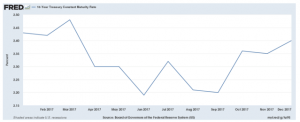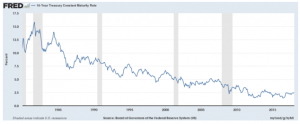Around this time last year, I first started to write about a potential bear market in bonds – but not because I believed one was necessarily imminent. I was actually referring to forecasts being made by some well-known managers in the bond world. The argument being widely circulated at the time was that bond yields had found their bottom and would start a multi-year ‘bear market,’ where yields would climb for many years to come.
Yet, here’s what actually happened in 2017:
10-Year US Treasury (2017)

As you can see from the graph above, the 10-year US Treasury opened the year yielding 2.45% and ended the year yielding 2.40%. As a refresher for readers, there is an inverse relationship between yields and prices when it comes to bonds. As the yield on a bond falls like it did for the 10-Year in 2017, its price rises – and vice versa. With the yield on the 10-year U.S. Treasury actually falling on the year, it meant a positive return on the year for U.S. Treasuries. Indeed, the Bloomberg Barclays Global U.S. Treasury was up a modest, but still positive 3.3%, and TIPS as measured by the Bloomberg Barclays Global Inflation Linked US TIPS were up 3.5%. So much for that forecasted bear market (according to JP Morgan).
Though a bearish call on U.S. Treasuries would have been wrong at the outset of 2017, the argument was not without merit. Bonds have arguably been in a secular bull market since late 1981, as the yield on the 10-year has progressively fallen from around 15% at its peak to down around 2.5% today (it’s been hovering around 2% for the better part of five years). Taking a look at a long-term chart of the 10-year, one can see the ‘bottoming’ formation over the last few years (Federal Reserve Bank of St. Louis).
10-Year US Treasury Since January 1, 1980

Our bearish outlook for bonds, at least in 2018, is based on two key expectations: higher inflation and tighter financial conditions. Both seem likely, in my view.
1) Higher Inflation:
On the inflation front, the tightening in labor markets has begun to stimulate modestly faster wage growth, which we could see continuing in the new year (according to Bureau of Labor Statistics). Wage growth plus reductions in personal taxes should, in my view, provide a decent boost to income and spending in the middle of 2018, which could flow through to price pressures. If and/or as inflation pressures mount, bond yields will, in my opinion, likely have to move higher as investors demand higher yields to compensate for eroding purchasing power. Consider that since 1960, the average spread between the 10-year Treasury and the CPI has been 2.4%. Today, it is a mere 0.15% (according to Mauldin Economics).
2) Tighter Financial Conditions:
On the financial conditions front, based on official Fed statements, it seems nearly assured that the Federal Reserve is going to raise interest rates in 2018. We think it could be as many as three rate hikes, but time will tell. Regardless, we see upward pressure on the short-end of the yield curve and an overall tightening of monetary conditions. Both should serve to put upward pressure on interest rates.
But the key factor we look at here at Zacks Investment Management is the term structure of interest rates, which is just another way of saying ‘the yield curve.’ As it stands right now, the yield curve is still upward sloping with the 2-Year US Treasury at around 2%, the 10-Year at ~2.5%, and the 30-Year at ~2.8% (U.S. Department of the Treasury). Assuming the yield curve remains slightly upward sloping on the year and that short rates move higher, we would expect the long end of the curve to gently move higher as well. In other words, we see interest rates rising in 2018, but not at a brisk pace.
Bottom Line for Investors
I would not worry too much when you see or hear that bonds may be at the cusp of a ‘bear market.’ Sure, interest rates are expected to rise, which also means that the prices of bonds could fall. But, I do not think the move will happen quickly or at any kind of alarming rate. What I do think, however, is that investors should consider evaluating the fixed income portions of portfolios to potentially shift away from long duration U.S. Treasuries and more towards short duration bonds, while also considering diversifying into other areas, like corporates and municipals.
Disclosure
Past performance is no guarantee of future results. Inherent in any investment is the potential for loss.
Zacks Investment Management, Inc. is a wholly-owned subsidiary of Zacks Investment Research. Zacks Investment Management is an independent Registered Investment Advisory firm and acts as an investment manager for individuals and institutions. Zacks Investment Research is a provider of earnings data and other financial data to institutions and to individuals.
This material is being provided for informational purposes only and nothing herein constitutes investment, legal, accounting or tax advice, or a recommendation to buy, sell or hold a security. Do not act or rely upon the information and advice given in this publication without seeking the services of competent and professional legal, tax, or accounting counsel. The information contained herein has been obtained from sources believed to be reliable but we do not guarantee accuracy or completeness. Publication and distribution of this article is not intended to create, and the information contained herein does not constitute, an attorney-client relationship. No recommendation or advice is being given as to whether any investment or strategy is suitable for a particular investor. It should not be assumed that any investments in securities, companies, sectors or markets identified and described were or will be profitable. All information is current as of the date of herein and is subject to change without notice. Any views or opinions expressed may not reflect those of the firm as a whole.
Any projections, targets, or estimates in this report are forward looking statements and are based on the firm’s research, analysis, and assumptions. Due to rapidly changing market conditions and the complexity of investment decisions, supplemental information and other sources may be required to make informed investment decisions based on your individual investment objectives and suitability specifications. All expressions of opinions are subject to change without notice. Clients should seek financial advice regarding the appropriateness of investing in any security or investment strategy discussed in this presentation.
The information and statistical data contained herein have been obtained from sources which we believe are reliable but in no way are warranted by us to accuracy or completeness.
Any investment inherently involves a high degree of risk, beyond the specific risks discussed herein and should be considered only by investors who can withstand the loss of all or a substantial part of their investment